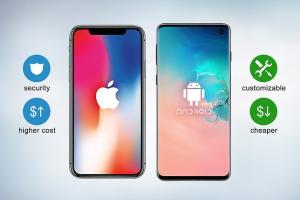Ultimate Guide: How to Choose the Perfect Smartphone for Your Needs

-
Quick Links:
- Introduction
- Understanding Your Needs
- Key Features to Consider
- Budgeting for Your Smartphone
- Operating Systems Overview
- Popular Smartphone Brands
- Case Studies
- Expert Insights
- Final Recommendations
- FAQs
Introduction
In the fast-evolving world of mobile technology, selecting the right smartphone can be a daunting task. With countless models available, ranging from budget-friendly options to high-end devices, understanding how to choose a smartphone that meets your specific needs is crucial. This guide will help you navigate the myriad of choices and find the perfect smartphone for you.
Understanding Your Needs
The first step in choosing a smartphone is to assess your personal requirements. Consider the following questions:
- What primary functions do you need? (e.g., calling, texting, gaming, photography)
- How often do you use your smartphone?
- Do you need a phone for professional use, casual use, or both?
- What type of apps do you frequently use?
- How important is camera quality for you?
Key Features to Consider
1. Performance
The performance of a smartphone is largely determined by its processor and RAM. High-performance processors (like Apple's A-series or Qualcomm's Snapdragon series) ensure smooth multitasking and fast app loading times.
2. Battery Life
Battery capacity is measured in milliampere-hours (mAh). A smartphone with at least 3000mAh is typically sufficient for a full day of moderate use. Additionally, consider the charging technology offered (e.g., fast charging, wireless charging).
3. Camera Quality
If photography is important to you, look for smartphones with high-resolution cameras, optical image stabilization, and various photography modes. Reviews and samples can help gauge real-world performance.
4. Display
The size and quality of the display matter. Look for high-resolution displays (at least 1080p) with vibrant colors and good brightness. AMOLED displays often provide better color contrast than LCDs.
5. Software and Updates
Operating systems (OS) play a significant role in user experience. Ensure the smartphone you choose runs on the latest OS version and that the manufacturer offers regular updates.
Budgeting for Your Smartphone
Determine how much you are willing to spend before you start shopping. Smartphones can range from budget options under $300 to flagship models over $1000. Generally, mid-range smartphones provide a good balance of performance and features without breaking the bank.
Operating Systems Overview
The two main operating systems are Android and iOS.
- Android: Offers a wider range of devices and customization options.
- iOS: Known for its smooth user experience and regular updates, but limited to Apple devices.
Popular Smartphone Brands
Some of the leading smartphone brands include:
- Apple
- Samsung
- Xiaomi
- OnePlus
- Oppo
Case Studies
To provide deeper insights, we analyzed user experiences with different smartphone models. For instance:
Case Study 1: The Everyday User
Sarah, a graphic designer, chose the Google Pixel 6 for its camera quality and stock Android experience. She reported enhanced productivity and satisfaction with her photography needs.
Case Study 2: The Gamer
John, a mobile gamer, opted for the ASUS ROG Phone 5, which features a high-refresh-rate display and powerful specifications, significantly improving his gaming experience.
Expert Insights
Industry experts suggest prioritizing your needs over brand loyalty. Consider reviews from credible sources and don't hesitate to test devices in-store before making a decision.
Final Recommendations
After thorough research and analysis, we recommend considering the following smartphones in 2023 based on various needs:
- Best Budget Option: Moto G Power (2023)
- Best Mid-Range Phone: Google Pixel 6a
- Best High-End Phone: iPhone 14 Pro
FAQs
1. What features should I prioritize in a smartphone?
Focus on performance, battery life, camera quality, and software updates based on your specific needs.
2. How often should I upgrade my smartphone?
Consider upgrading every 2-3 years, especially if your current device no longer meets your needs.
3. Are refurbished smartphones a good option?
Yes, if purchased from reputable sellers, refurbished smartphones can offer excellent value.
4. What is the best operating system for me?
Choose Android for customization and variety, or iOS for simplicity and consistency.
5. How do I know if a smartphone is worth the price?
Research reviews, compare specifications, and consider the brand's reputation for quality.
6. Should I consider 5G compatibility?
If you plan to keep your smartphone for several years, 5G compatibility may be worth considering.
7. What is the average lifespan of a smartphone?
Most smartphones last between 2-4 years, depending on usage and maintenance.
8. How can I protect my smartphone?
Use a case, screen protector, and consider insurance for added protection.
9. Are there smartphones specifically designed for gaming?
Yes, brands like ASUS and Razer offer smartphones tailored for gaming performance.
10. Can I transfer data from my old smartphone to a new one?
Most smartphones have built-in tools to assist with data transfer, making the process seamless.
Conclusion
Choosing the right smartphone involves careful consideration of your personal needs, budget, and the features that matter most to you. By taking the time to research, compare, and analyze, you can find a device that not only meets your expectations but enhances your daily life.
References
- Android Authority - Smartphone Buying Guide
- Consumer Reports - How to Choose a Smartphone
- TechRadar - How to Choose the Best Smartphone for You
Random Reads
- How to refresh yahoo mail
- How to refresh repair leather
- How to find waterfall pokemon black
- How to find the iqr
- Troubleshooting low water pressure
- Troubleshoot sound issues windows
- Apple id sign out unavailable fix
- Remove dent stainless steel refrigerator
- Remove a stuck screw
- Safely remove water charging port